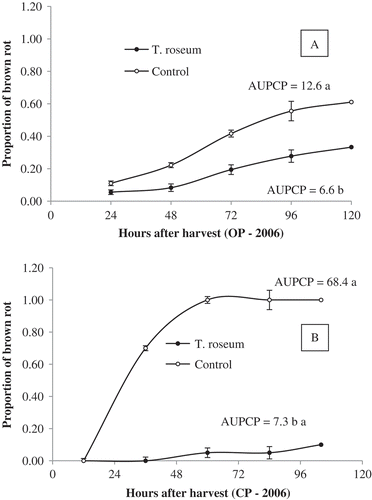Figures & data
Table 1. Description of treatments, spray schedules and rates of treatments used to control blossom blight and brown rot in peaches of ‘Granada’ and ‘Chimarrita’ in Rio do Sul – SC, Brazil (2005 and 2006).
Table 2. Incidence (%) of blossom blight on flowers after incubation in the laboratory of cultivars ‘Granada’ and ‘Chimarrita’, collected before spraying (BS) and after spraying (AS) with the treatments, in 2005 and 2006, in Rio do Sul – SC, Brazil.
Table 3. Average incidence of latent infection of Monilinia fructicola on green fruit (after incubation in the laboratory) and brown rot incidence (%) at harvest and post-harvest on ‘Chimarrita’in 2005 and 2006 in Rio do Sul – SC, Brazil.
Table 4. Averages of temperature (T), relative humidity (RH) and rainfall, 10 days before the collection of flower, green fruit and mature fruit at harvest of ‘Granada’ and ‘Chimarrita’ in 2005 and 2006 in Rio do Sul – SC, Brazil.
Fig. 1 Progress of brown rot of peach ‘Chimarrita’ post-harvest after treatment with Trichothecium roseum (TR). (A) OP = Fruit were collected from an organic orchard (no conventional fungicides applied during the season). Inoculum for post-harvest brown rot infection was from field infections (fruit were not inoculated post-harvest). (B) CP = Fruits harvested from a conventional production orchard (with fungicides applied in the field). Harvested fruit were inoculated with 105 conidia mL−1 Monilinia fructicola 12 h after treatment with TR. In both cases, fruits were dipped in a 106 conidia mL−1 suspension of TR for 1 min. Proportion of brown rot of 0.8 is equal to 80% of incidence.

